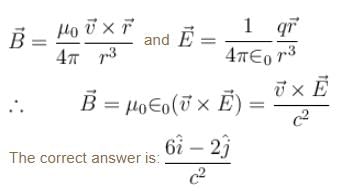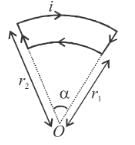All Exams >
ACT >
Science for ACT >
All Questions
All questions of Electromagnetism for ACT Exam
A circular loop of radius a is made of a single turn of thin conducting wire. The self inductance of this loop is L. If the number of turns in the loop is increased from 1 to 8, the self inductance would be :- a)

- b)L/8
- c)8L
- d)64L
Correct answer is option 'D'. Can you explain this answer?
A circular loop of radius a is made of a single turn of thin conducting wire. The self inductance of this loop is L. If the number of turns in the loop is increased from 1 to 8, the self inductance would be :
a)

b)
L/8
c)
8L
d)
64L
|
|
Vedika Singh answered |
Let us consider there are n turns of a coil having radius a and current I. Then magnetic field at the centre of the coil is given by.

Flux of magnetic field through a coil.
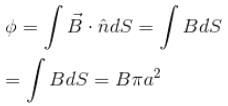
Flux through n coil
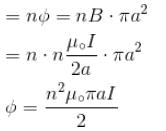
Self inductance given by relation
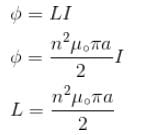
If number of turns in the loop is increased from 1 to 8 then, Self inductance increased by 64 time.
The correct answer is: 64L

If number of turns in the loop is increased from 1 to 8 then, Self inductance increased by 64 time.
The correct answer is: 64L
The current carrying wire and rod AB are in the same plane. The rod moves parallel to the wire with a velocity v. Which one of the following statement is true about induced emf in the rod.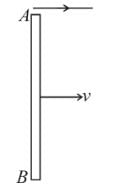
- a)There will be no induced emf in the rod
- b)End A will be at lower potential with respect to B
- c)A and B will be at the same potential
- d)Potential at A will be higher than at B
Correct answer is option 'D'. Can you explain this answer?
The current carrying wire and rod AB are in the same plane. The rod moves parallel to the wire with a velocity v. Which one of the following statement is true about induced emf in the rod.

a)
There will be no induced emf in the rod
b)
End A will be at lower potential with respect to B
c)
A and B will be at the same potential
d)
Potential at A will be higher than at B
|
|
Vedika Singh answered |
When the rod move in the magnetic field due to current carrying wire. The emf is induced in the rod.
Magnetic field due to current carrying wire is

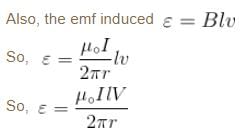
So B is farther from A
So B is at lower potential.
The correct answer is: Potential at A will be higher than at B
A coil has an area of 0.05 m2 and it has 800 turns. It is placed perpendicularly in a magnetic field of strength 4 × 10–5 wb/m2. It is rotated through 90° in 0.1s. The average emf induced in the coil is :- a)0.056 V
- b)0.046 V
- c)0.016 V
- d)0.026 V
Correct answer is option 'C'. Can you explain this answer?
A coil has an area of 0.05 m2 and it has 800 turns. It is placed perpendicularly in a magnetic field of strength 4 × 10–5 wb/m2. It is rotated through 90° in 0.1s. The average emf induced in the coil is :
a)
0.056 V
b)
0.046 V
c)
0.016 V
d)
0.026 V
|
|
Vedika Singh answered |
According to Faraday’s law
Induced emf, 
Where flux through the coil

θ is the angle between magnetic field and unit normal to the surface.

Where flux through the coil

θ is the angle between magnetic field and unit normal to the surface.
when coil is rotated from 0° to 90° then total change in magnetic flux is given by
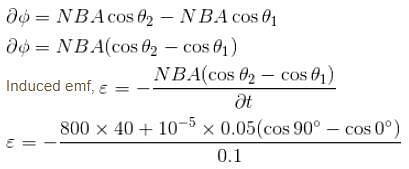
= 0.016 V
The correct answer is: 0.016 V
The correct answer is: 0.016 V
The negatively and uniformly charged nonconducting disc as shown in the figure is rotated clockwise with great angular speed. Which of the following is not the direction of the magnetic field at point A in the plane of the disc :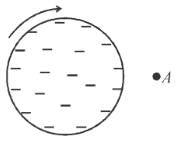
- a)into the page
- b)up the page
- c)out of the page
- d)down the page
Correct answer is option 'B,C,D'. Can you explain this answer?
The negatively and uniformly charged nonconducting disc as shown in the figure is rotated clockwise with great angular speed. Which of the following is not the direction of the magnetic field at point A in the plane of the disc :

a)
into the page
b)
up the page
c)
out of the page
d)
down the page
|
|
Vedika Singh answered |
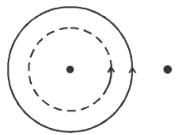
Disc behaves like made up of coils arranged in a plane in which current is flowing in anti-clockwise direction.
Hence, the field at A is direction into the page.
The correct answers are: out of the page, up the page, down the page
Hence, the field at A is direction into the page.
The correct answers are: out of the page, up the page, down the page
A Positive point charge is moving in clockwise direction in a circle with constant speed. Consider the magnetic field produced by the charge at a point P (not centre of the circle) on the axis of the circle. Which of the following is incorrect.- a)it is constant in direction and magnitude both
- b)it is not constant in magnitude and direction both.
- c)it is constant in direction only
- d)it is constant in magnitude only
Correct answer is option 'A,B,C'. Can you explain this answer?
A Positive point charge is moving in clockwise direction in a circle with constant speed. Consider the magnetic field produced by the charge at a point P (not centre of the circle) on the axis of the circle. Which of the following is incorrect.
a)
it is constant in direction and magnitude both
b)
it is not constant in magnitude and direction both.
c)
it is constant in direction only
d)
it is constant in magnitude only
|
|
Waheeda Khan answered |
Introduction:
When a positive point charge moves in a circular path with constant speed, it creates a magnetic field around it. This magnetic field can be analyzed at a point P on the axis of the circle. Let's analyze the given options to determine which one is incorrect.
Analysis:
a) It is constant in direction and magnitude both.
If the point charge is moving in a circular path with constant speed, the magnetic field it produces at point P will also be constant in direction and magnitude both. This is because the charge is moving in a uniform circular motion, and the magnetic field produced by a moving charge depends only on its velocity, not on its position. Therefore, option a) is correct.
b) It is not constant in magnitude and direction both.
This statement is incorrect. As mentioned earlier, the magnetic field produced by the moving charge is constant in direction and magnitude both. So, option b) is incorrect.
c) It is constant in direction only.
This statement is incorrect. The magnetic field produced by the moving charge is not only constant in direction but also constant in magnitude. So, option c) is incorrect.
d) It is constant in magnitude only.
This statement is incorrect. The magnetic field produced by the moving charge is constant in both direction and magnitude. So, option d) is incorrect.
Conclusion:
After analyzing the given options, we can conclude that options a), b), and c) are incorrect. The correct statement is that the magnetic field produced by the positive point charge moving in a circular path with constant speed is constant in both direction and magnitude.
When a positive point charge moves in a circular path with constant speed, it creates a magnetic field around it. This magnetic field can be analyzed at a point P on the axis of the circle. Let's analyze the given options to determine which one is incorrect.
Analysis:
a) It is constant in direction and magnitude both.
If the point charge is moving in a circular path with constant speed, the magnetic field it produces at point P will also be constant in direction and magnitude both. This is because the charge is moving in a uniform circular motion, and the magnetic field produced by a moving charge depends only on its velocity, not on its position. Therefore, option a) is correct.
b) It is not constant in magnitude and direction both.
This statement is incorrect. As mentioned earlier, the magnetic field produced by the moving charge is constant in direction and magnitude both. So, option b) is incorrect.
c) It is constant in direction only.
This statement is incorrect. The magnetic field produced by the moving charge is not only constant in direction but also constant in magnitude. So, option c) is incorrect.
d) It is constant in magnitude only.
This statement is incorrect. The magnetic field produced by the moving charge is constant in both direction and magnitude. So, option d) is incorrect.
Conclusion:
After analyzing the given options, we can conclude that options a), b), and c) are incorrect. The correct statement is that the magnetic field produced by the positive point charge moving in a circular path with constant speed is constant in both direction and magnitude.
A charged particle enters a uniform magnetic field with velocity vector at an angle of 45° with the magnetic field. The pitch of the helical path followed by the particle is p. The radius of the helix will be :- a)

- b)

- c)

- d)

Correct answer is option 'A'. Can you explain this answer?
A charged particle enters a uniform magnetic field with velocity vector at an angle of 45° with the magnetic field. The pitch of the helical path followed by the particle is p. The radius of the helix will be :
a)

b)

c)

d)

|
|
Vedika Singh answered |
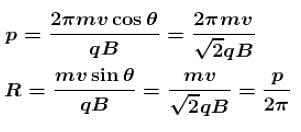
The correct answer is: 

A coil of metal wire is kept stationary in a uniform magnetic field :
- a)an emf is induced in the coil
- b)a current is induced in the coil
- c)neither emf nor current is induced
- d)both ‘a’ and ‘b’
Correct answer is option 'C'. Can you explain this answer?
A coil of metal wire is kept stationary in a uniform magnetic field :
a)
an emf is induced in the coil
b)
a current is induced in the coil
c)
neither emf nor current is induced
d)
both ‘a’ and ‘b’
|
|
Omkar Rana answered |
A) an emf is induced in the coil
d) both an emf and a current are induced in the coil
d) both an emf and a current are induced in the coil
A nonconducting disc having uniform positive charge Q, is rotating about its axis in anticlockwise direction with uniform angular velocity ω. The magnetic field at the center of the disc is.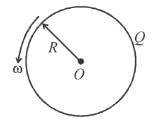
- a)having magnitude

- b)directed outward
- c)directed inwards
- d)having magnitude

Correct answer is option 'B,D'. Can you explain this answer?
A nonconducting disc having uniform positive charge Q, is rotating about its axis in anticlockwise direction with uniform angular velocity ω. The magnetic field at the center of the disc is.

a)
having magnitude 

b)
directed outward
c)
directed inwards
d)
having magnitude 

|
|
Arghya answered |
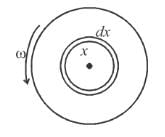
Consider a ring of radius x and thickness dx.
Equivalent current in this ring 

dB (due to this ring) 
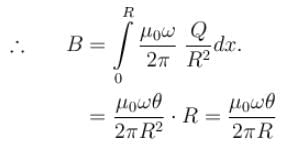
The correct answers are: directed outward, having magnitude


The correct answers are: directed outward, having magnitude

A charged particle (charge q) is moving in a circle of radius R with uniform speed v. The associated magnetic moment µ is given by :- a)

- b)

- c)

- d)

Correct answer is option 'A'. Can you explain this answer?
A charged particle (charge q) is moving in a circle of radius R with uniform speed v. The associated magnetic moment µ is given by :
a)

b)

c)

d)

|
|
Mister Genius answered |
As revolving charge is equivalent to a current, so


where R is radius of circle and v is uniform speed of charged particle.

Now, magnetic moment associated with charged particle is given by
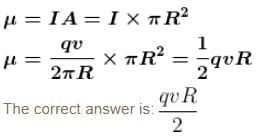
A long solenoid carrying a current produce’s a magnetic field B along its axis. If the current is doubled acid the number of turns per cm is halved, the new value of the magnetic field is :- a)B/2
- b)2B
- c)4B
- d)B
Correct answer is option 'D'. Can you explain this answer?
A long solenoid carrying a current produce’s a magnetic field B along its axis. If the current is doubled acid the number of turns per cm is halved, the new value of the magnetic field is :
a)
B/2
b)
2B
c)
4B
d)
B
|
|
Vedika Singh answered |
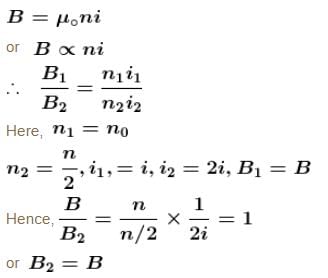
The correct answer is: B
Two infinitely long linear conductors are arranged perpendicular to each other and are in mutually perpendicular planes as shown in figure. If I1 = 2A along the y-axis and I2 = 3A along negative z-axis and AP = AB = 1cm. The value of magnetic field strength  at P is -
at P is -
- a)

- b)

- c)

- d)

Correct answer is option 'D'. Can you explain this answer?
Two infinitely long linear conductors are arranged perpendicular to each other and are in mutually perpendicular planes as shown in figure. If I1 = 2A along the y-axis and I2 = 3A along negative z-axis and AP = AB = 1cm. The value of magnetic field strength  at P is -
at P is -
 at P is -
at P is -
a)

b)

c)

d)

|
|
Vedika Singh answered |
Magnetic field strength at P due to I1

Magnetic field strength at P due the I2

In the figure shown A B C D E F A was a square loop of side l, but is folded in two equal parts so that half of it lies in x z plane and the other half lies in the i'. The magnetic field at the centre is :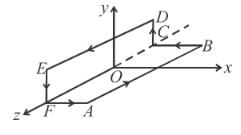
- a)

- b)

- c)

- d)

Correct answer is option 'C'. Can you explain this answer?
In the figure shown A B C D E F A was a square loop of side l, but is folded in two equal parts so that half of it lies in x z plane and the other half lies in the i'. The magnetic field at the centre is :

a)

b)

c)

d)

|
|
Jayant Mishra answered |
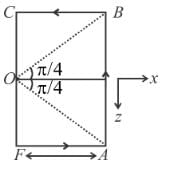
Due to FABC the magnetic field at O is along y-axis and due to CDEF the magnetic field is along x-axis.
Hence the field will be of the form
Calculating field due to FABC :
due to AB :
 Due to BC :
Due to BC :
Hence the field will be of the form

Calculating field due to FABC :
due to AB :
 Due to BC :
Due to BC :
Similarly due to FA :
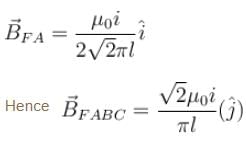

Similarly due to CDEF :
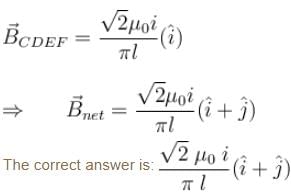
A particle of charge ‘q’ and mass ‘m’ enters normally (at point P) in a region of magnetic field with speed v. It comes out normally from Q after time T as shown in figure. The magnetic field B is present only in the region of radius R and is constant and uniform. Initial and final velocities are along radial direction and they are perpendicular to each other. For this to happen, which of the following expression(s) is/are correct :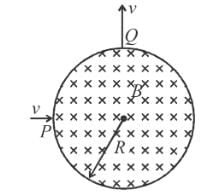
- a)

- b)

- c)

- d)None of these
Correct answer is option 'A,B,C'. Can you explain this answer?
A particle of charge ‘q’ and mass ‘m’ enters normally (at point P) in a region of magnetic field with speed v. It comes out normally from Q after time T as shown in figure. The magnetic field B is present only in the region of radius R and is constant and uniform. Initial and final velocities are along radial direction and they are perpendicular to each other. For this to happen, which of the following expression(s) is/are correct :

a)

b)

c)

d)
None of these
|
|
Vedika Singh answered |
The particle will move along an arc which is part of a circle of radius

From the figure we can see r = R
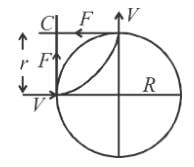
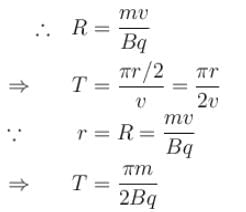
The correct answers are:

A conducting rod of length a is rotating with constant angular speed ω about its perpendicular bisector. A uniform magnetic field B exist parallel to the axis of rotation. The emf induced between two ends of the rod is.- a)

- b)0
- c)

- d)Bωa2
Correct answer is option 'C'. Can you explain this answer?
A conducting rod of length a is rotating with constant angular speed ω about its perpendicular bisector. A uniform magnetic field B exist parallel to the axis of rotation. The emf induced between two ends of the rod is.
a)

b)
0
c)

d)
Bωa2
|
|
Vedika Singh answered |
Let us calculate motional emf produced in the rod. Consider a unit positive charge on the rod at a distance r from the centre. Let rod rotates with angular velocity ω. Velocity of this unit positive charge in magnetic field in transverse direction is ωr.
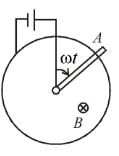
Lorentz force acting on the unit charge

Potential difference between A and O = VAO
work done in moving a unit positive charge from O to A.
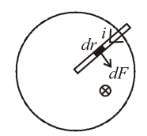
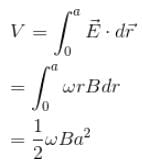
The correct answer is: 

A metal disc of radius a rotates with an angular velocity ω about an axis perpendicular to its plane passing through its centre in a magnetic field of induction B acting perpendicular to the plane of the disc. The induced emf between the rim and axis of the disc.- a)-2Bπ2a2
- b)

- c)-Bπa2ω
- d)-Bπa2
Correct answer is option 'B'. Can you explain this answer?
A metal disc of radius a rotates with an angular velocity ω about an axis perpendicular to its plane passing through its centre in a magnetic field of induction B acting perpendicular to the plane of the disc. The induced emf between the rim and axis of the disc.
a)
-2Bπ2a2
b)

c)
-Bπa2ω
d)
-Bπa2
|
|
Vedika Singh answered |
In the presence of uniform magnetic field B perpendicular to the disc in outward direction (say) Force on a unit positive charge

 will lie in radially outward direction)
will lie in radially outward direction)Work done in moving a unit positive charge from centre to the rim is equal to potential difference ε
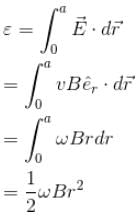
The correct answer is:

A loop is formed by two parallel conductor connected by a solenoid with inductance L and a conducting rod of mass m which can freely (without friction) side over the conductors. The conductors are located in horizontal plane in a uniform vertical magnetic field B. The distance between the conductor is l. Then angular frequency of rod.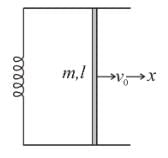
- a)

- b)

- c)

- d)

Correct answer is option 'A'. Can you explain this answer?
A loop is formed by two parallel conductor connected by a solenoid with inductance L and a conducting rod of mass m which can freely (without friction) side over the conductors. The conductors are located in horizontal plane in a uniform vertical magnetic field B. The distance between the conductor is l. Then angular frequency of rod.

a)

b)

c)

d)

|
|
Vedika Singh answered |
Let at any instant of time, velocity of the rod is v towards right. The current in the circuit is i. In the figure,

Va – Vb = Vd – Vc
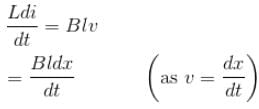
i.e. Ldi = Bldx
Li = Blx

Magnetic force on the rod at this instant is

Since, this force is in opposite direction of
 so from Newton’s second law we an write
so from Newton’s second law we an write
Comparing this with equation of SHM, i.e.,

Determine the magnetic field at the centre of the current carrying wire arrangement shown in the figure. The arrangement extends to infinity. (The wires joining the successive squares are along the line passing through the centre)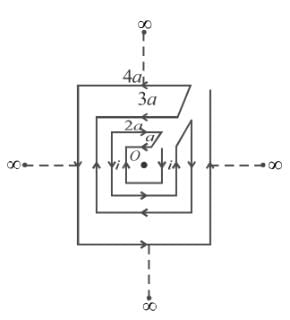
- a)

- b)0
- c)

- d)None of these
Correct answer is option 'C'. Can you explain this answer?
Determine the magnetic field at the centre of the current carrying wire arrangement shown in the figure. The arrangement extends to infinity. (The wires joining the successive squares are along the line passing through the centre)

a)

b)
0
c)

d)
None of these

|
Pie Academy answered |

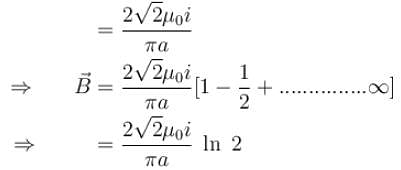

The self inductance of solenoid of length L area of cross-section A and having N turns is- a)

- b)

- c)

- d)

Correct answer is option 'D'. Can you explain this answer?
The self inductance of solenoid of length L area of cross-section A and having N turns is
a)

b)

c)

d)

|
|
Vedika Singh answered |
Let a solenoid cross-sectional area A and N turns. We know, in case of solenoid magnetic field along the axis of solenoid is given by

Where N is the number of turns and I is the current flowing in the solenoid.
Flux through coil of solenoid
Flux through coil of solenoid

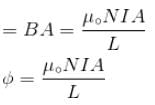
Total flux = number of turns × flux through one coil.

Now we know

where L is self inductance
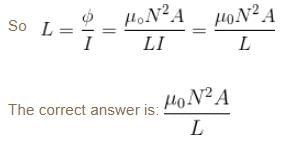
A wire coil of length l, mass m, is sliding without friction on conducting rail ax and by as shown in figure. The vertical rails are connected to one another via an external resistance R. The entire circuit is placed in a region of space having a uniform magnetic field B. The field is perpendicular to the plane of circuit and directed outwards. The steady speed of rod cd is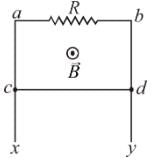
- a)

- b)

- c)

- d)

Correct answer is option 'C'. Can you explain this answer?
A wire coil of length l, mass m, is sliding without friction on conducting rail ax and by as shown in figure. The vertical rails are connected to one another via an external resistance R. The entire circuit is placed in a region of space having a uniform magnetic field B. The field is perpendicular to the plane of circuit and directed outwards. The steady speed of rod cd is

a)

b)

c)

d)


|
Pie Academy answered |
Let wire cd is at distance x from the edge be considered a plane surface bounded by the loop acdb and unit normal vector  lying in same direction as
lying in same direction as 
 lying in same direction as
lying in same direction as 
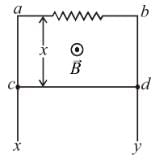
Flux through area acdb
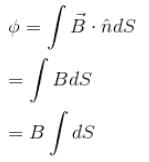

= Blv
Since, Flux is increasing with time, emf will be induced so as to circulate current resulting in weakening of magnetic field. So, current should flow from P to Q.
Current

Lorentz force acting on rod 
= ilB are perpendicular
are perpendicular
 (forward up the incline)
(forward up the incline)

= ilB
 are perpendicular
are perpendicular (forward up the incline)
(forward up the incline)Free body diagram of slide is shown in figure.
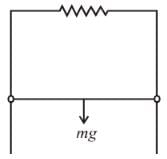
There is no acceleration in direction perpendicular to plane of the loop.
So, N = O [N Normal reaction perpendicular to the plane]
But in the plane of the loop, the wire cd slide down due to gravitational force acting downward and lorentz force acting upward.
So, In downward direction
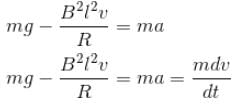
But when we talk about steady speed,
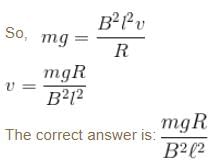

But when we talk about steady speed,


A metallic rod completes its circuit as shown in the figure. The circuit is normal to a magnetic field of B = 0.15 tesla. If the resistances of the rod is 3Ω the force required to move the rod with a constant velocity of 2 m/sec is - 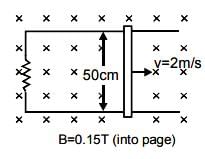
- a) 3.75 × 10–4 N
- b)3.75 × 102 N
- c)3.75 × 10–2 N
- d)3.75 × 10–3 N
Correct answer is option 'D'. Can you explain this answer?
A metallic rod completes its circuit as shown in the figure. The circuit is normal to a magnetic field of B = 0.15 tesla. If the resistances of the rod is 3Ω the force required to move the rod with a constant velocity of 2 m/sec is -

a)
3.75 × 10–4 N
b)
3.75 × 102 N
c)
3.75 × 10–2 N
d)
3.75 × 10–3 N
|
|
Jayant Mishra answered |
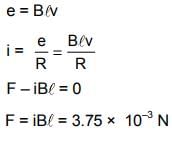
A charge particle of charge q, mass m is moving with initial velocity v as shown in figure in a uniform magnetic field  Select the correct alternative/alternatives :
Select the correct alternative/alternatives :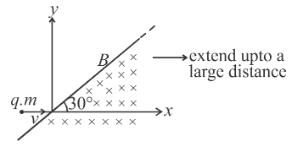
- a)Velocity of particle when it comes out from magnetic field is

- b)Time for which the particle was in magnetic field is

- c)Distance traveled in magnetic field is

- d)The particle will never come out of magnetic field
Correct answer is option 'A,B,C'. Can you explain this answer?
A charge particle of charge q, mass m is moving with initial velocity v as shown in figure in a uniform magnetic field  Select the correct alternative/alternatives :
Select the correct alternative/alternatives :
 Select the correct alternative/alternatives :
Select the correct alternative/alternatives :
a)
Velocity of particle when it comes out from magnetic field is 

b)
Time for which the particle was in magnetic field is 

c)
Distance traveled in magnetic field is 

d)
The particle will never come out of magnetic field

|
Pie Academy answered |
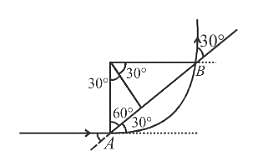
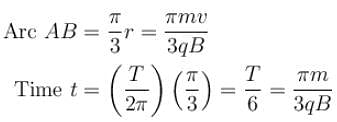
The correct answers are: Velocity of particle when it comes out from magnetic field is  Time for which the particle was in magnetic field is
Time for which the particle was in magnetic field is  Distance traveled in magnetic field is
Distance traveled in magnetic field is 
 Time for which the particle was in magnetic field is
Time for which the particle was in magnetic field is  Distance traveled in magnetic field is
Distance traveled in magnetic field is 
Lenz’s Law is due to conservation of :- a)charge
- b)energy
- c)momentum
- d)current
Correct answer is option 'B'. Can you explain this answer?
Lenz’s Law is due to conservation of :
a)
charge
b)
energy
c)
momentum
d)
current
|
|
Jayant Mishra answered |
The correct answer is: energy
A long thick conducting cylinder of radius ‘R’ carries a current uniformly distributed over its cross section.- a)The strength of the magnetic field inside the cylinder will vary as inversely proportional to r, where r is the distance from the axis.
- b)The energy density of the magnetic field outside the conductor varies as inversely proportional to 1/r2, where ‘r’ is the distance from the axis.
- c)The magnetic field strength is maximum on the surface
- d)The magnetic field strength is zero on the surface
Correct answer is option 'B,C'. Can you explain this answer?
A long thick conducting cylinder of radius ‘R’ carries a current uniformly distributed over its cross section.
a)
The strength of the magnetic field inside the cylinder will vary as inversely proportional to r, where r is the distance from the axis.
b)
The energy density of the magnetic field outside the conductor varies as inversely proportional to 1/r2, where ‘r’ is the distance from the axis.
c)
The magnetic field strength is maximum on the surface
d)
The magnetic field strength is zero on the surface
|
|
Vedika Singh answered |
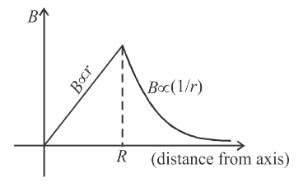
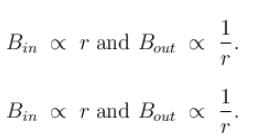
Alterante solution
B (inside the conductor) ∝ r, B(outside the conductor)


The correct answers are: The magnetic field strength is maximum on the surface, The energy density of the magnetic field outside the conductor varies as inversely proportional to 1/r2, where ‘r’ is the distance from the axis.
The induced emf in a coil rotating in a uniform magnetic field depend upon.- a)only on total number of turns in the coil
- b)only on the magnetic field
- c)area of the coil and speed of rotation
- d)All of the above
Correct answer is option 'D'. Can you explain this answer?
The induced emf in a coil rotating in a uniform magnetic field depend upon.
a)
only on total number of turns in the coil
b)
only on the magnetic field
c)
area of the coil and speed of rotation
d)
All of the above
|
|
Jayant Mishra answered |
The correct answer is: All of the above
From a cylinder of radius R, a cylinder of radius R/2 is removed, as shown. Current flowing in the remaining cylinder is I. Magnetic field strength is :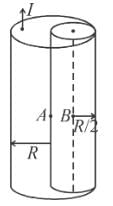
- a)zero at point A
- b)zero at point B
- c)

- d)

Correct answer is option 'C,D'. Can you explain this answer?
From a cylinder of radius R, a cylinder of radius R/2 is removed, as shown. Current flowing in the remaining cylinder is I. Magnetic field strength is :

a)
zero at point A
b)
zero at point B
c)

d)


|
Pie Academy answered |
For cylinder
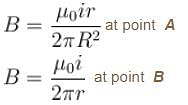
We can consider the given cylinder as a combination of two cylinders. One of radius ‘R’ carrying current. I in one direction and other of radius R/2 carrying current I/3 in both directions.

The correct answers are:

A large circular coil of N turns and radius R carries a time varying current I = I0 sin (ωt). A small circular coil of n turns and radius r (r << R) is placed at the center of the large coil such that the coils are concentric and coplanar. The induced emf in the small coil :- a)leads the current in the large coil by π/2
- b)lags the current in the large coil by π/2
- c)is in phase with the current in the large coil.
- d)lags the current in the large coil by π
Correct answer is option 'B'. Can you explain this answer?
A large circular coil of N turns and radius R carries a time varying current I = I0 sin (ωt). A small circular coil of n turns and radius r (r << R) is placed at the center of the large coil such that the coils are concentric and coplanar. The induced emf in the small coil :
a)
leads the current in the large coil by π/2
b)
lags the current in the large coil by π/2
c)
is in phase with the current in the large coil.
d)
lags the current in the large coil by π
|
|
Vedika Singh answered |
Flux through small coil is
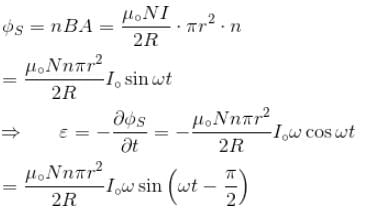
Hence, emf is lay behind the large coil current by π/2
The correct answer is: lags the current in the large coil by π/2
The correct answer is: lags the current in the large coil by π/2
If a charged particle of charge to mass ratio q/m = α is entering in a uniform magnetic field of strength B which is extended up to 4d as shown in figure at a speed v = 2αdB, then which of the following is incorrect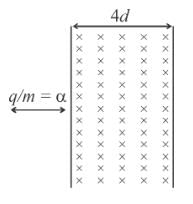
- a)the time for which particle will be in the magnetic field is 2π/αβ
- b)the charge will move on a circular path and will come out from magnetic field at a distance 4d from the point of insertion.
- c)angle subtended by charged particle at the centre of circular path is 2π
- d)the charged particle will subtended an angle of 90° at the centre of circular path
Correct answer is option 'A,C,D'. Can you explain this answer?
If a charged particle of charge to mass ratio q/m = α is entering in a uniform magnetic field of strength B which is extended up to 4d as shown in figure at a speed v = 2αdB, then which of the following is incorrect

a)
the time for which particle will be in the magnetic field is 2π/αβ
b)
the charge will move on a circular path and will come out from magnetic field at a distance 4d from the point of insertion.
c)
angle subtended by charged particle at the centre of circular path is 2π
d)
the charged particle will subtended an angle of 90° at the centre of circular path
|
|
Vedika Singh answered |
Electromagnetic force will provide the necessary centripetal force.
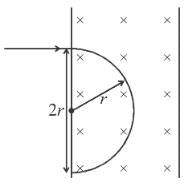

⇒

i.e. the electron will move out after traveling on a semicircular path of radius r = 2d.
The correct answers are: angle subtended by charged particle at the centre of circular path is 2π, the time for which particle will be in the magnetic field is  the charged particle will subtended an angle of 90° at the centre of circular path
the charged particle will subtended an angle of 90° at the centre of circular path
 the charged particle will subtended an angle of 90° at the centre of circular path
the charged particle will subtended an angle of 90° at the centre of circular pathTwo parallel rails separated by a distance l are connected through a resistance R in yz plane. Magnetic field  is present in the direction perpendicular to the plane of the rails. A conducting rod of mass. m placed on the rails and given a velocity of v0 parallel to the plane of rails. The expression for the velocity.
is present in the direction perpendicular to the plane of the rails. A conducting rod of mass. m placed on the rails and given a velocity of v0 parallel to the plane of rails. The expression for the velocity.- a)

- b)

- c)

- d)

Correct answer is option 'C'. Can you explain this answer?
Two parallel rails separated by a distance l are connected through a resistance R in yz plane. Magnetic field  is present in the direction perpendicular to the plane of the rails. A conducting rod of mass. m placed on the rails and given a velocity of v0 parallel to the plane of rails. The expression for the velocity.
is present in the direction perpendicular to the plane of the rails. A conducting rod of mass. m placed on the rails and given a velocity of v0 parallel to the plane of rails. The expression for the velocity.
 is present in the direction perpendicular to the plane of the rails. A conducting rod of mass. m placed on the rails and given a velocity of v0 parallel to the plane of rails. The expression for the velocity.
is present in the direction perpendicular to the plane of the rails. A conducting rod of mass. m placed on the rails and given a velocity of v0 parallel to the plane of rails. The expression for the velocity.a)

b)

c)

d)


|
Pie Academy answered |
Let the distance of slider from AB is y. Consider an element of length y and width dz at a distance z from the y axis.

dS = ydz
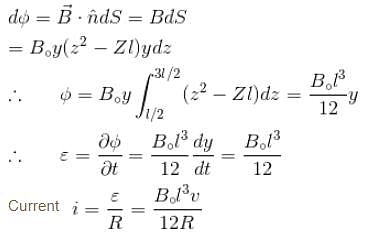
consider a length dz of the rod
∴ Magnetic force on rod dF = iB·dz
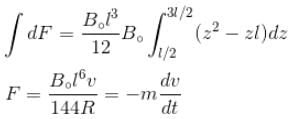
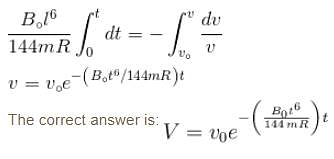
Two long cylinders (with axis parallel) are arranged as shown to form overlapping cylinders, each of radius r, whose centers are separated by a distance d. Current of density J (Current per unit area) flows into the plane of page along the right shaded part of one cylinder and an equal current flows out of the plane of the page along the left shaded part of the other, as shown in the figure. The magnitude and direction of magnetic field at point O (O is the origin of shown x-y axes) are :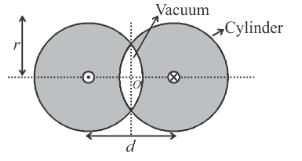
- a)

- b)

- c)zero
- d)none of these
Correct answer is option 'A'. Can you explain this answer?
Two long cylinders (with axis parallel) are arranged as shown to form overlapping cylinders, each of radius r, whose centers are separated by a distance d. Current of density J (Current per unit area) flows into the plane of page along the right shaded part of one cylinder and an equal current flows out of the plane of the page along the left shaded part of the other, as shown in the figure. The magnitude and direction of magnetic field at point O (O is the origin of shown x-y axes) are :

a)

b)

c)
zero
d)
none of these
|
|
Vedika Singh answered |
Let the current density in complete left cylinder is  , then current density in complete right cylinder is
, then current density in complete right cylinder is  . Then magnetic field at any point P in the region of overlap is
. Then magnetic field at any point P in the region of overlap is
 , then current density in complete right cylinder is
, then current density in complete right cylinder is  . Then magnetic field at any point P in the region of overlap is
. Then magnetic field at any point P in the region of overlap is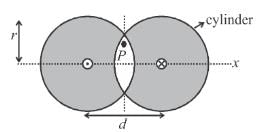

Therefore magnitude of field at any point in region of overlap is  and its direction is along positive y-direction at any point P in overlap region.
and its direction is along positive y-direction at any point P in overlap region.
The correct answer is: in the + y -direction
in the + y -direction
 and its direction is along positive y-direction at any point P in overlap region.
and its direction is along positive y-direction at any point P in overlap region.The correct answer is:
 in the + y -direction
in the + y -directionA ring of mass m, radius r having charge q uniformly distributed over it and free to rotate about its own axis is placed in a region having a magnetic field B parallel to its axis. If the magnetic field is suddenly switched off, the angular velocity acquired by the ring is :- a)

- b)

- c)

- d)None of these
Correct answer is option 'C'. Can you explain this answer?
A ring of mass m, radius r having charge q uniformly distributed over it and free to rotate about its own axis is placed in a region having a magnetic field B parallel to its axis. If the magnetic field is suddenly switched off, the angular velocity acquired by the ring is :
a)

b)

c)

d)
None of these

|
Pie Academy answered |


Figure shows an amperian path ABCDA. Part ABC is in vertical plane PSTU while part CDA is in horizontal plane PQRS. Direction of circulation along the path is shown by an arrow near point B and at D.  for this path according to Ampere’s law will be :
for this path according to Ampere’s law will be :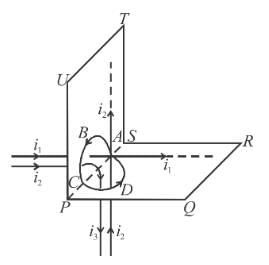
- a)

- b)

- c)

- d)

Correct answer is option 'C'. Can you explain this answer?
Figure shows an amperian path ABCDA. Part ABC is in vertical plane PSTU while part CDA is in horizontal plane PQRS. Direction of circulation along the path is shown by an arrow near point B and at D.  for this path according to Ampere’s law will be :
for this path according to Ampere’s law will be :
 for this path according to Ampere’s law will be :
for this path according to Ampere’s law will be :
a)

b)

c)

d)


|
Pie Academy answered |


In a region magnetic field along x-axis changes with time according to the given graph. If time period, pitch and radius of helix path are T0, P0 and R respectively then which of the following is correct if the particle is projected at an angle θ0 with the positive x-axis in x-y plane.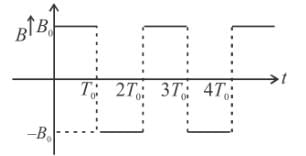
- a)
 co-ordinates of charge are
co-ordinates of charge are 
- b)At
 co-ordinates of charge are
co-ordinates of charge are 
- c)Two extremes from x-axis are at a distance 4R0 from each other.
- d)Two extremes from x-axis are at a distance 2R0 from each other.
Correct answer is option 'A,B,D'. Can you explain this answer?
In a region magnetic field along x-axis changes with time according to the given graph. If time period, pitch and radius of helix path are T0, P0 and R respectively then which of the following is correct if the particle is projected at an angle θ0 with the positive x-axis in x-y plane.

a)
 co-ordinates of charge are
co-ordinates of charge are 
b)
At  co-ordinates of charge are
co-ordinates of charge are 
 co-ordinates of charge are
co-ordinates of charge are 
c)
Two extremes from x-axis are at a distance 4R0 from each other.
d)
Two extremes from x-axis are at a distance 2R0 from each other.
|
|
Vedika Singh answered |
As the magnetic field is along the x-axis, the magnetic force will be along negative z-axis from t = 0 to t = T0 and along positive z-axis from

t = T0 to t = 2T0
For t = 0 to t = T0
At 

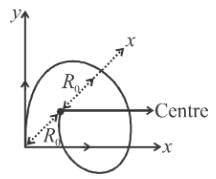

y-coordinate = 0 (from figure)
and z-coordinate = –2R0 (from figure)
and z-coordinate = –2R0 (from figure)
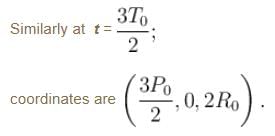
The correct answers are: At
 co-ordinates of charge are
co-ordinates of charge are  co-ordinates of charge are
co-ordinates of charge are  Two extremes from x-axis are at a distance 2R0 from each other.
Two extremes from x-axis are at a distance 2R0 from each other.A magnet is brought towards a coil (i) speedily and (ii) slowly then the induced emf/induced charge will be respectively.- a)more in first case/equal in both case
- b)less in first case/equal in both case
- c)less in first case/more is second case
- d)more in first case/more in first case
Correct answer is option 'A'. Can you explain this answer?
A magnet is brought towards a coil (i) speedily and (ii) slowly then the induced emf/induced charge will be respectively.
a)
more in first case/equal in both case
b)
less in first case/equal in both case
c)
less in first case/more is second case
d)
more in first case/more in first case
|
|
Vedika Singh answered |
According to Faraday’s law.

The magnitude of induced emf is directly proportional to the rate of change of magnetic flux. So induced emf will be more in first case.
We also know ε = iR
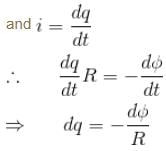
So, induced charge in a coil is independent of time taken to charge the flux.
The correct answer is: more in first case/equal in both case
The correct answer is: more in first case/equal in both case
An electron and proton enter a uniform magnetic field perpendicular. Both have same kinetic energy. Which of the following is true?- a)Both trajectories are equally curved
- b)Trajectory of proton is less curved
- c)Trajectory of electron is less curved
- d)Both move on straight line path
Correct answer is option 'B'. Can you explain this answer?
An electron and proton enter a uniform magnetic field perpendicular. Both have same kinetic energy. Which of the following is true?
a)
Both trajectories are equally curved
b)
Trajectory of proton is less curved
c)
Trajectory of electron is less curved
d)
Both move on straight line path
|
|
Vedika Singh answered |
When a charged particle enters a magnetic field perpendicularly, it moves on a circular path. The required centripetal force is provided by magnetic force.
i.e. magnetic force = Centripetal force.
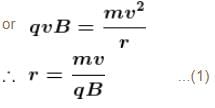
Now kinetic energy of the particle 



Therefore, Eq. (1) become
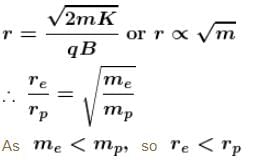
Hence trajectory of proton is less curved.
The correct answer is: Trajectory of proton is less curved
The magnetic flux φ (in weber) in a closed circuit of resistance 10Ω varies with time t (in second) according to equation φB = 6t2 - 5t + 1. The magnitude of induced current at t = 0.25sec is :- a)1.2A
- b)0.2A
- c)0.8A
- d)0.6A
Correct answer is option 'B'. Can you explain this answer?
The magnetic flux φ (in weber) in a closed circuit of resistance 10Ω varies with time t (in second) according to equation φB = 6t2 - 5t + 1. The magnitude of induced current at t = 0.25sec is :
a)
1.2A
b)
0.2A
c)
0.8A
d)
0.6A
|
|
Ira Choudhury answered |
The magnetic flux is a measure of the total magnetic field passing through a given surface area. It is defined as the dot product of the magnetic field and the surface area vector. Mathematically, the magnetic flux (Φ) can be calculated using the equation:
Φ = B * A * cosθ
where B is the magnetic field, A is the area vector, and θ is the angle between the magnetic field and the area vector.
The unit of magnetic flux is the Weber (Wb) in the International System of Units (SI).
Φ = B * A * cosθ
where B is the magnetic field, A is the area vector, and θ is the angle between the magnetic field and the area vector.
The unit of magnetic flux is the Weber (Wb) in the International System of Units (SI).
Three infinite current carrying conductors are placed as shown in figure. Two wires carry same current while current in third wire is unknown. The three wires do not intersect with each other and all of them are in the plane of paper. Which of the following is incorrect about a point ‘P’ which is also in the same plane :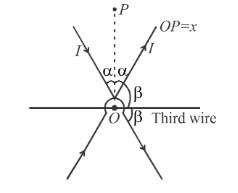
- a)If the current in the third wire is
 (right to left) then magnetic field will be zero at P for all value of x.
(right to left) then magnetic field will be zero at P for all value of x. - b)Magnetic field intensity at P is zero for all values of x.
- c)If the current in the third wire is
 (left to right) then magnetic field will be zero at P for all values of x.
(left to right) then magnetic field will be zero at P for all values of x. - d)If the current in the third wire is
 (right to left) then magnetic field will be zero at P for all value of x.
(right to left) then magnetic field will be zero at P for all value of x.
Correct answer is option 'A,B,C'. Can you explain this answer?
Three infinite current carrying conductors are placed as shown in figure. Two wires carry same current while current in third wire is unknown. The three wires do not intersect with each other and all of them are in the plane of paper. Which of the following is incorrect about a point ‘P’ which is also in the same plane :

a)
If the current in the third wire is  (right to left) then magnetic field will be zero at P for all value of x.
(right to left) then magnetic field will be zero at P for all value of x.
 (right to left) then magnetic field will be zero at P for all value of x.
(right to left) then magnetic field will be zero at P for all value of x.b)
Magnetic field intensity at P is zero for all values of x.
c)
If the current in the third wire is  (left to right) then magnetic field will be zero at P for all values of x.
(left to right) then magnetic field will be zero at P for all values of x.
 (left to right) then magnetic field will be zero at P for all values of x.
(left to right) then magnetic field will be zero at P for all values of x. d)
If the current in the third wire is  (right to left) then magnetic field will be zero at P for all value of x.
(right to left) then magnetic field will be zero at P for all value of x.
 (right to left) then magnetic field will be zero at P for all value of x.
(right to left) then magnetic field will be zero at P for all value of x.|
|
Vedika Singh answered |
Magnetic field at ‘P’ due to wires (1) and (2) is :
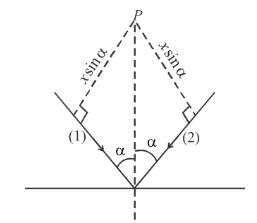
 (out of the paper)
(out of the paper)The correct answers are: Magnetic field intensity at P is zero for all values of x., If the current in the third wire is  (left to right) then magnetic field will be zero at P for all values of x., If the current in the third wire is
(left to right) then magnetic field will be zero at P for all values of x., If the current in the third wire is  (right to left) then magnetic field will be zero at P for all value of x.
(right to left) then magnetic field will be zero at P for all value of x.
 (left to right) then magnetic field will be zero at P for all values of x., If the current in the third wire is
(left to right) then magnetic field will be zero at P for all values of x., If the current in the third wire is  (right to left) then magnetic field will be zero at P for all value of x.
(right to left) then magnetic field will be zero at P for all value of x.The current in inner coil is i = 2t2, as shown in figure. The current induced in the outer coil has a resistance of R.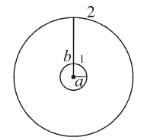
- a)

- b)

- c)

- d)

Correct answer is option 'C'. Can you explain this answer?
The current in inner coil is i = 2t2, as shown in figure. The current induced in the outer coil has a resistance of R.

a)

b)

c)

d)


|
Pie Academy answered |
Let I be the current be in the outer coil 2.
The field at centre
The flux through the inner coil due to current in the outer coil 2,

So, Mutual inductance of outer coil
The field at centre

The flux through the inner coil due to current in the outer coil 2,

So, Mutual inductance of outer coil
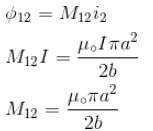
Flux across the outer coil,
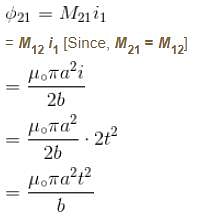
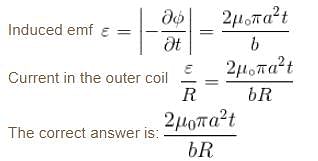
A current loop consists of two identical semicircular parts each of radius R, one lying in the x - y plane and the other in x - z plane. If the current in the loop is i. The resultant magnetic field due to the two semiconductor parts at their common centre is :- a)

- b)

- c)

- d)

Correct answer is option 'A'. Can you explain this answer?
A current loop consists of two identical semicircular parts each of radius R, one lying in the x - y plane and the other in x - z plane. If the current in the loop is i. The resultant magnetic field due to the two semiconductor parts at their common centre is :
a)

b)

c)

d)


|
Pie Academy answered |
The loop mentioned in the question must look like one as shown in the figure.
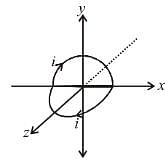
Magnetic field at the centre due to semicircular loop lying in x-y plane.
 in negative z direction.
in negative z direction.Similarly field due to loop in x-z plane, in negative y direction.
in negative y direction.
 in negative y direction.
in negative y direction.∴ Magnetic of resultant magnetic field,


If the magnetic field at ‘P’ in the given figure can be written as  then K is:
then K is: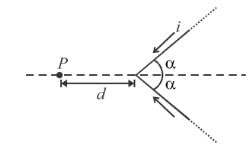
- a)

- b)

- c)

- d)

Correct answer is option 'A'. Can you explain this answer?
If the magnetic field at ‘P’ in the given figure can be written as  then K is:
then K is:
 then K is:
then K is:
a)

b)

c)

d)


|
Pie Academy answered |
Let us compute the magnetic field due to any one segment :




Resultant field will be :


For paramagnetic materials magnetic susceptibility is related with temperature as :- a)∝T-2
- b)∝T-1
- c)∝T2
- d)∝T1
Correct answer is option 'B'. Can you explain this answer?
For paramagnetic materials magnetic susceptibility is related with temperature as :
a)
∝T-2
b)
∝T-1
c)
∝T2
d)
∝T1
|
|
Jayant Mishra answered |
For paramagnetic materials magnetic susceptibility is inversely proportional to the temperature i.e., proportional to T–1.
The correct answer is: ∝T-1
The correct answer is: ∝T-1
Two coil of self inductance L1 and L2 are placed closed to each other so that total flux in one coil is completely linked with other. If M is the mutual inductance between them, then :- a)

- b)M = L1/L2
- c)M = (L1L2)2
- d)M = L1L2
Correct answer is option 'A'. Can you explain this answer?
Two coil of self inductance L1 and L2 are placed closed to each other so that total flux in one coil is completely linked with other. If M is the mutual inductance between them, then :
a)

b)
M = L1/L2
c)
M = (L1L2)2
d)
M = L1L2

|
Pie Academy answered |
When the flux changes in the second coil due to change in the current in first coil, then the mutual inductance is given by the relation.

Similarly, when flux changes in first coil due to change in the current in second coil.

From the Reciprocity Theorem
M21 = M12 = M
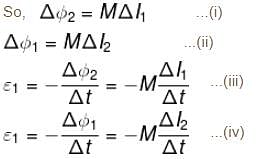
From (iii) and (iv)
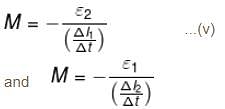

Multiply (v) and (vi)






An infinite long wire carrying a current I(t) = I0 cos(ωt) is placed at a distance a from a square loop of side a in the figure. If the resistance of the loop is R, then the amplitude of the induced current in the loop is :
- a)

- b)

- c)

- d)

Correct answer is option 'A'. Can you explain this answer?
An infinite long wire carrying a current I(t) = I0 cos(ωt) is placed at a distance a from a square loop of side a in the figure. If the resistance of the loop is R, then the amplitude of the induced current in the loop is :

a)

b)

c)

d)


|
Pie Academy answered |
To find out the flux through the loop. Consider an element of length a and breadth dx at a distance x from wire.
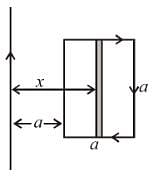
∴ Area = adx = dS
Let the orientation of the loop is such that  lie in same direction,
lie in same direction,  is unit normal to surface.
is unit normal to surface.
 lie in same direction,
lie in same direction,  is unit normal to surface.
is unit normal to surface.Magnetic field due to long current carrying conductor wire.
at a distance x is given by
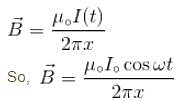

Flux of magnetic field through  element
element

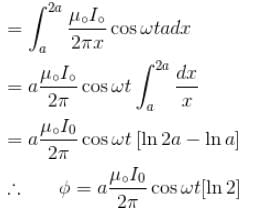


 element
element



Chapter doubts & questions for Electromagnetism - Science for ACT 2025 is part of ACT exam preparation. The chapters have been prepared according to the ACT exam syllabus. The Chapter doubts & questions, notes, tests & MCQs are made for ACT 2025 Exam. Find important definitions, questions, notes, meanings, examples, exercises, MCQs and online tests here.
Chapter doubts & questions of Electromagnetism - Science for ACT in English & Hindi are available as part of ACT exam.
Download more important topics, notes, lectures and mock test series for ACT Exam by signing up for free.
Science for ACT
486 videos|517 docs|337 tests
|
Signup to see your scores go up within 7 days!
Study with 1000+ FREE Docs, Videos & Tests
10M+ students study on EduRev

Contact Support
Our team is online on weekdays between 10 AM - 7 PM
Typical reply within 3 hours
|
Free Exam Preparation
at your Fingertips!
Access Free Study Material - Test Series, Structured Courses, Free Videos & Study Notes and Prepare for Your Exam With Ease

 Join the 10M+ students on EduRev
Join the 10M+ students on EduRev
|

|
Forgot Password
OR
Signup to see your scores
go up within 7 days!
Access 1000+ FREE Docs, Videos and Tests
Takes less than 10 seconds to signup

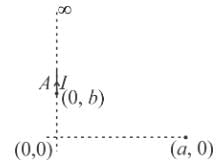



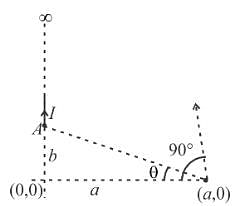
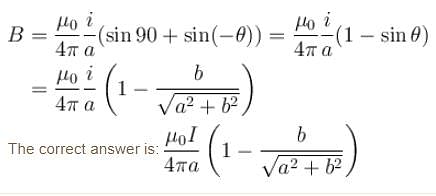










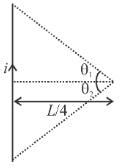

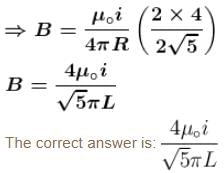
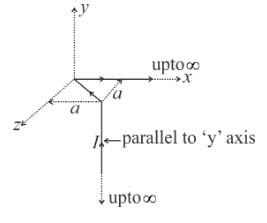




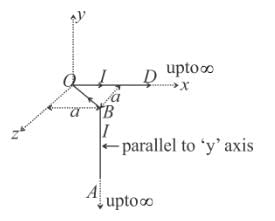



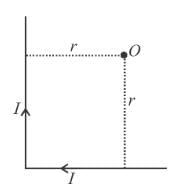



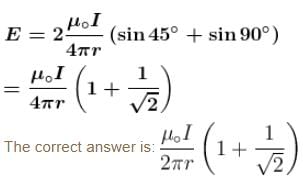
 and it produces an electric field at a point given by
and it produces an electric field at a point given by  It will produce magnetic field at that point equal to (all quantities are S.I. units)
It will produce magnetic field at that point equal to (all quantities are S.I. units)

